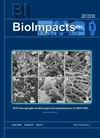Non-invasive and probeless rapid in-vitro monitoring and quantification of HUVECs counts based on FFT impedimetery
IF 2.2
4区 工程技术
Q3 PHARMACOLOGY & PHARMACY
引用次数: 0
Abstract
Introduction: The endothelial cells derived from the human vein cord (HUVECs) are used as in-vitro models for studying cellular and molecular pathophysiology, drug and hormones transport mechanisms, or pathways. In these studies, the proliferation and quantity of cells are important features that should be monitored and assessed regularly. So rapid, easy, noninvasive, and inexpensive methods are favorable for this purpose. Methods: In this work, a novel method based on fast Fourier transform square-wave voltammetry (FFTSWV) combined with a 3D printed electrochemical cell including two inserted platinum electrodes was developed for non-invasive and probeless rapid in-vitro monitoring and quantification of human umbilical vein endothelial cells (HUVECs). The electrochemical cell configuration, along with inverted microscope images, provided the capability of easy use, online in-vitro monitoring, and quantification of the cells during proliferation. Results: HUVECs were cultured and proliferated at defined experimental conditions, and standard cell counts in the initial range of 12 500 to 175 000 were prepared and calibrated by using a hemocytometer (Neubauer chamber) counting for electrochemical measurements. The optimum condition, for FFTSWV at a frequency of 100 Hz and 5 mV amplitude, were found to be a safe electrochemical measurement in the cell culture medium. In each run, the impedance or admittance measurement was measured in a 5 seconds time window. The total measurements were fulfilled at 5, 24, and 48 hours after the seeding of the cells, respectively. The recorded microscopic images before every electrochemical assay showed the conformity of morphology and objective counts of cells in every plate well. The proposed electrochemical method showed dynamic linearity in the range of 12 500-265 000 HUVECs 48 hours after the seeding of cells. Conclusion: The proposed electrochemical method can be used as a simple, fast, and noninvasive technique for tracing and monitoring of HUVECs population in in-vitro studies. This method is highly cheap in comparison with other traditional tools. The introduced configuration has the versatility to develop electrodes for the study of various cells and the application of other electrochemical designations.基于FFT阻抗的HUVECs计数无创无探针快速体外监测与定量
来源于人静脉索的内皮细胞(HUVECs)被用作体外模型,用于研究细胞和分子病理生理,药物和激素的转运机制或途径。在这些研究中,细胞的增殖和数量是应定期监测和评估的重要特征。因此,快速、简便、无创和廉价的方法是实现这一目的的有利条件。方法:基于快速傅立叶变换方波伏安法(FFTSWV)结合3D打印电化学电池(含两个插入铂电极),开发了一种无创、无探针的体外快速监测和定量人脐静脉内皮细胞(HUVECs)的新方法。电化学电池配置,以及倒置显微镜图像,提供了易于使用的能力,在线体外监测,并在细胞增殖过程中定量。结果:HUVECs在规定的实验条件下进行了培养和增殖,制备了初始范围为12 500 ~ 175 000的标准细胞计数,并使用血细胞计(Neubauer室)计数进行了电化学测量。结果表明,频率为100 Hz,振幅为5 mV的FFTSWV是一种安全的电化学测量方法。在每次运行中,阻抗或导纳测量在5秒的时间窗口内测量。总测量分别在细胞播种后5、24和48小时完成。每次电化学分析前记录的显微镜图像显示每个板孔中细胞的形态和客观计数的一致性。在12 500 ~ 265 000 HUVECs范围内,该电化学方法在细胞播种后48 h呈动态线性关系。结论:该电化学方法可作为一种简便、快速、无创的体外HUVECs种群追踪和监测技术。与其他传统工具相比,这种方法非常便宜。所介绍的结构具有通用性,可用于研究各种电池和其他电化学指定的应用。
本文章由计算机程序翻译,如有差异,请以英文原文为准。
求助全文
约1分钟内获得全文
求助全文
来源期刊

Bioimpacts
Pharmacology, Toxicology and Pharmaceutics-Pharmaceutical Science
CiteScore
4.80
自引率
7.70%
发文量
36
审稿时长
5 weeks
期刊介绍:
BioImpacts (BI) is a peer-reviewed multidisciplinary international journal, covering original research articles, reviews, commentaries, hypotheses, methodologies, and visions/reflections dealing with all aspects of biological and biomedical researches at molecular, cellular, functional and translational dimensions.
 求助内容:
求助内容: 应助结果提醒方式:
应助结果提醒方式:


